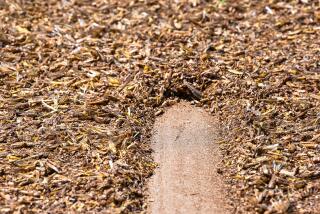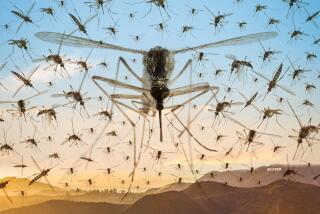Crops Threatened : Africa Girds for New War on Locusts
- Share via
DEALI, Senegal — Clusters of inch-long grasshoppers were humming ominously amid the leafy millet stalks here a few weeks ago when four lumbering U.S. airplanes, flying in formation, appeared in the sky and showered the crops with thousands of gallons of the pesticide malathion.
Grasshoppers, flies, mosquitoes and virtually every other enemy of the farmer promptly vanished from the broad savannah around this West African village.
But when Bassirou Ndiaye, 66, stepped into his fields here a few days ago, thousands of tiny insects were jumping around his ankles. They were all over the blacktop road nearby.
“They’re even in our rooms,” he said.
The grasshoppers were back.
20 Countries Threatened
West Africa is battling its worst grasshopper infestation in half a century, and much of the rest of the continent is bracing for potentially catastrophic invasions of locusts, as well. In all, five varieties of the swarming insects threaten food crops in 20 countries from South Africa northward to Ethiopia and from the Red Sea westward to Senegal.
The ravaging effects of swarming locusts have been well known in this part of the world since biblical times, when plagues of locusts were attributed to the wrath of God.
The Senegalese grasshopper, said entomologist F. M. Philips of Texas, is a “transition species” between locusts and the grasshoppers that are found in American backyards. At an inch long, it is less than half the size of a locust.
Grasshoppers and locusts are always around, but usually they prefer wild grasses to crops and are kept under control by natural predators such as birds.
Rapid Multiplication
But when their numbers rise above that small, stable population, they can multiply geometrically. One female grasshopper that lays eggs in June, for example, may have 18 million living descendants by October, three generations later.
“Once that log starts rolling, it’s very hard to stop,” said Philips, who is working in Senegal as a consultant for the U.S. Agency for International Development.
Overcrowding and lack of food bring about a behavioral change in locusts, transforming them from homebodies and loners into swarming mobs that ride high on the wind, sometimes blocking out the sun as they travel hundreds of miles, gobbling up entire fields of crops. Senegalese grasshoppers exhibit some of the same characteristics.
Most experts blame the very rain that brought relief to farmers after several years of drought for the current pest problems. When the intertropical weather front, which spans the continent, brought rain to the parched near-desert across north-central Africa, the insects simply hatched faster than their natural predators could eat them.
Man-Made Problem
Another problem has been man-made: Wars in Sudan, Ethiopia and other breeding grounds for locusts have prevented routine insect monitoring and control efforts. Also, many of the agencies formed over the years to fight locusts have disappeared, their financial support drying up with the drought when there were no locusts to fight.
The locusts usually breed in eastern Africa and have in the past moved westward across the continent of Africa and have even jumped the Red Sea between Africa and Saudi Arabia to the east.
In West Africa, not only Senegal but also areas of neighboring Mali and Mauritania and nearby Burkina Faso have been affected. In Senegal itself, where grasshoppers have infested 2.4 million acres, the battle against them has begun.
Four DC-7 airplanes, used in California, Idaho and other states for pest control, recently conducted one of the largest spraying operations ever attempted in Africa. In eight days, the planes covered nearly one million acres, killing about 95% of the hoppers.
‘Not Even Flies Stayed’
“Our problems had never been solved like this so quickly,” Ndiaye the farmer said. “Not even the flies stayed around.”
But the adult grasshoppers already had laid eggs under cover of the thick, sandy soil, and more spraying is desperately needed to eradicate that next generation.
The grasshopper here is a wily enemy, “a revolving, evolving target,” said George Carner, deputy director of the Agency for International Development here.
A second phase of the operation, using smaller planes in specific regions north of this village in central Senegal, has just begun. The U.N. Food and Agriculture Organization is coordinating that effort, funded by Canada, France and other donors.
$23 Million Sought
The battle is spreading. The U.N. group’s director general in Rome has appealed for $23 million over the next three years to help Africa fight the pests.
Lukas Brader, director of the Food and Agriculture Organization’s Emergency Center for Locust Operations in Rome, said that brown locusts are already a plague in Botswana and that a control program is under way.
In eastern and central Africa, locusts are just beginning to hatch as the rainy season begins, Brader said. Control organizations are preparing to fight desert locusts near the Red Sea, African migratory locusts in Sudan and Ethiopia and red locusts already spotted swarming in Tanzania and Zambia.
“The situation is still developing, and we can’t tell yet which way it is going to go,” Brader said. “I’m still hopeful we can get it under control.”
Locusts More Predictable
Locusts can consume more vegetation more quickly than Senegalese grasshoppers, but some experts say locusts are easier to fight because they have been studied so thoroughly. Entomologists know the traditional breeding grounds for locusts and are better able to predict their behavior. Swarming grasshoppers do not travel as far as locusts but, on the other hand, they are more difficult to second-guess.
Les crickets, as the grasshoppers are called in this former French colony, first began appearing in large numbers late last year when rains began turning this parched area green. In this area, the drought left behind hundreds of vulture nests on the gnarled branches of the baobab trees and grasshopper eggs in the ground.
Now, the Food and Agriculture Organization says, the insects are in an “ecological trap” of favorable food and weather conditions about 150 miles east of the seaside capital of Dakar. The continuing rains and the wealth of vegetation in the area make conditions perfect for grasshoppers.
Philips, the U.S. entomologist, took a walk through this region a few days ago and found as many as 100 to 400 grasshoppers per square yard. In areas not sprayed by the American planes, the concentrations were as high as 1,000 per square yard.
‘Takes Your Breath Away’
“It kind of takes your breath away when you see populations like that,” Philips said.
But the concern, as it usually is with these insects, is for the future. If the grasshoppers are allowed to grow to adulthood, in another few weeks, they will lay eggs and set up an even more severe problem for 1987.
U.S. officials, worried that localized spraying would not solve the problem, won approval from Washington for additional large-scale spraying last week. But as the U.S. spraying resumed, one of the four DC-7 aircraft crashed in the Atlantic after taking off from Dakar. Of the four crewmen, one was rescued, one died and two are missing.
The United States had already spent $1.5 million on the operation. Senegal paid $1.2 million for 56,000 gallons of the insecticide, which was ferried from the United States in three cargo Boeing 747s.
That operation “impeded an explosion of grasshoppers,” Carner said.
Canada and France Help
Canada, France and other countries have pitched in for the second and third phases of the operation, using small planes to focus on areas most heavily infested and providing insecticides for farmers to spray on their own.
In Deali, a small village of grass huts inhabited by Wolof-speaking farm families, the invasion of grasshoppers after rains broke the drought seemed to be “of God’s doing,” in the words of farmer Ndiaye.
In 66 years here, Ndiaye had seen a lot of different insects ruin his millet, peanuts, melons and beans. Last year, he planted three successive crops of millet, which is used to make couscous, the staple food of this area. But the grasshoppers ate every one.
So, he and other farmers around here were especially awed last month by the power of malathion, the same pesticide used to kill fruit flies in California.
‘It Was Good’
“After they sprayed, there was nothing here to bother us,” said Ndiaye’s brother Modou. “Everything the Americans told us would happen, happened. It was good.”
A year before, a few farmers in the area had sprayed their fields by hand with some powdered insecticide provided by the government.
“But it was an endless battle,” said Semou Niang, 38, a Deali farmer. “You would spray one day, and they were back the next. We didn’t have anything to harvest.”
Grateful as they are for the malathion, the farmers say they need more.
“In 20 days, we will harvest millet, if nothing ruins it,” Bassirou Ndiaye said recently. “But the crickets will be big in a week.”
The villagers look hopefully skyward whenever they hear the roar of planes.
“We always think they are coming to us,” said Bassirou Ndiaye, looking at a quiet sky, empty except for fluffy white clouds. “And when they go on by, we think they are coming back.”
More to Read
Sign up for Essential California
The most important California stories and recommendations in your inbox every morning.
You may occasionally receive promotional content from the Los Angeles Times.











